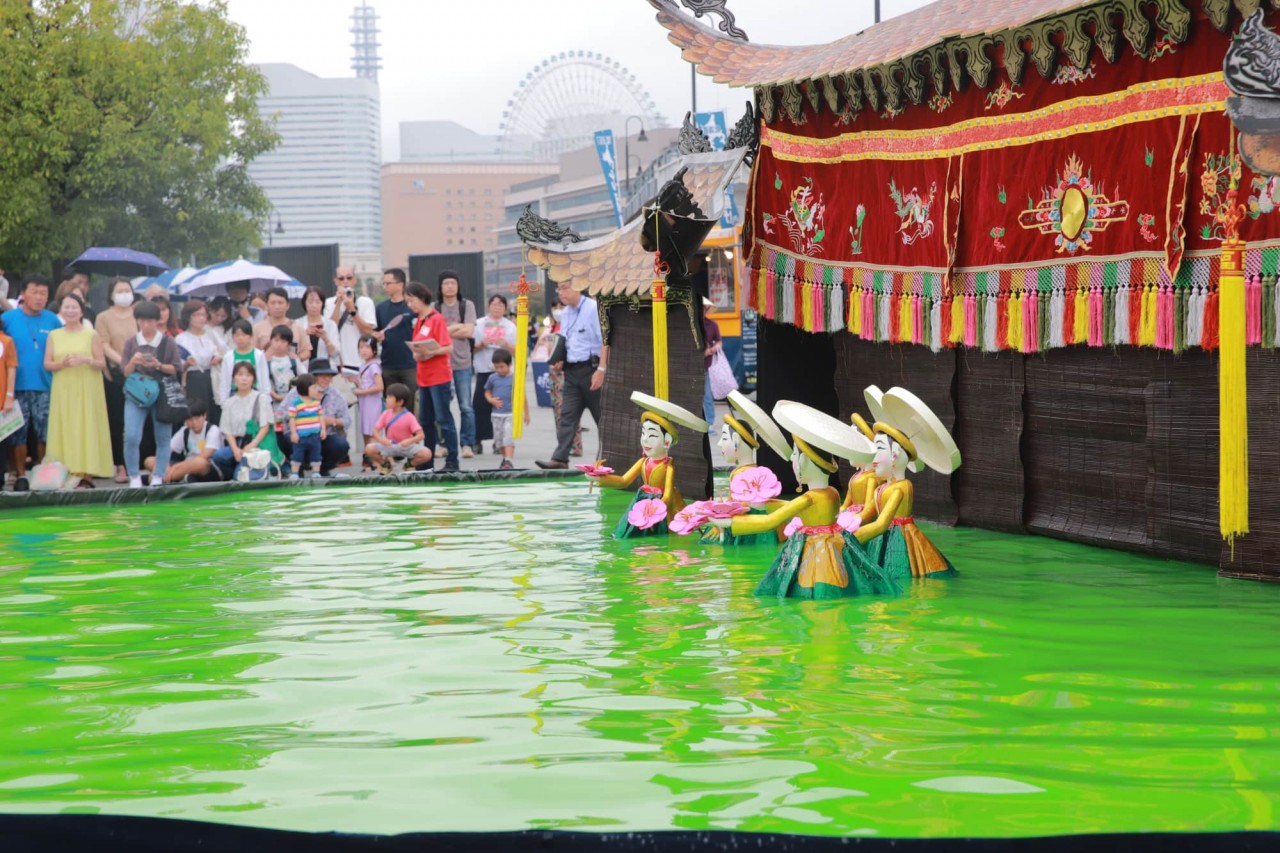Natural Mystery: The Unique Al Naslaa Rock Formation of Saudi Arabi
The Al Naslaa rock formation is a rock formation in Tayma oasis in Saudi Arabia. It has been split down the middle into two parts, both of which are balanced on their own tiny pedestal. The cause of the split is unknown, but is posited to be due to natural causes including windblown sand and periodic rain.
There are many natural mysteries in the world, one of which is particularly surprising in the Naslaa Rock in the Tayma desert in Saudi Arabia. Just by looking at this photo you can see how incredible this rock is, despite its huge size it’s still standing on such a small area with an almost perfect line split through the middle.
What is the mysterious history?
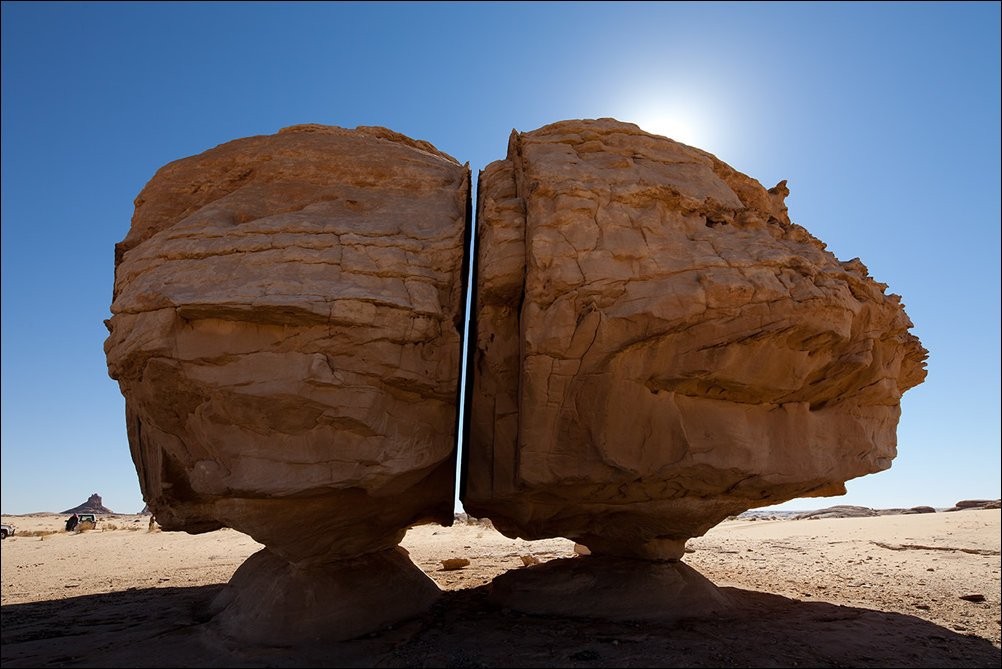 |
| Photo: Unusual Place |
According to the investigations of this great natural phenomenon, this area was inhabited over a thousand years ago. In some parts of the stone you can even see petroglyphs engraved in the rock.
Today, this part of the Saudi Arabian desert is a still under investigation for archaeological remains but it was formerly an important place for trade routes and meetings.
What makes the Al Naslaa formation famous
Al Naslaa is unique not only because of its shape, location, and age but also due to the precise break that separates one half of the formation from the other. While it may look like a simple crack in the foundation of the sandstone, the break is so exact and straight that it looks as if though someone took a laser to the rock to split it apart. In addition, the two remarkably heavy sides of the formation seem to balance on nothing more than thin pieces of rock, appearing to nearly gravitate in thin air.
In order to assess the nature of how the famed formation came to be, it’s important to recognize its history. The formation has existed since ancient times and has taken centuries to acquire its shape. Al Naslaa is only one of many rocks in the Tayma Oasis that features a unique appearance, as the limestone, shale, and sandstone there have spent centuries culturing into fantastic formations (with the help of a little rain and wind, of course).
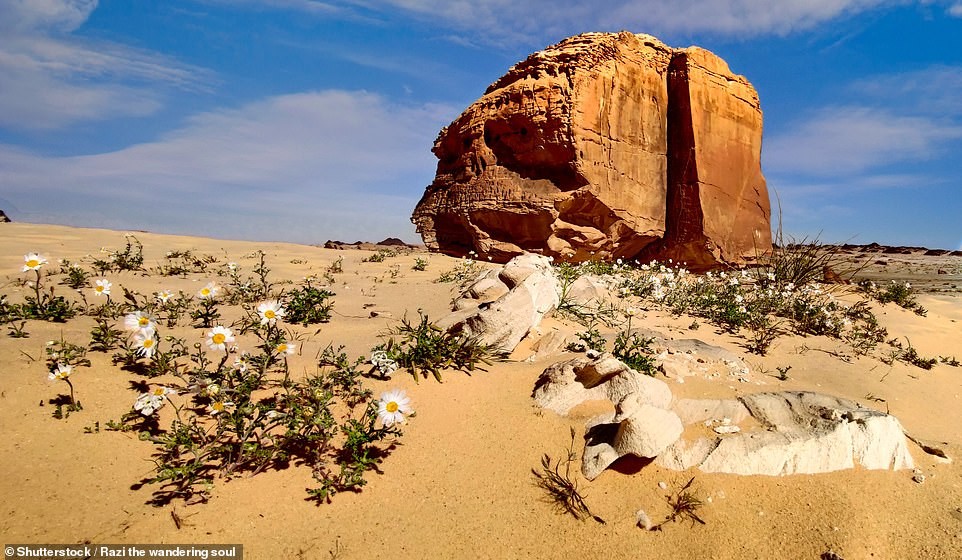 |
| Photo: Shutterstock |
Before these formations even developed into the stunning shapes they occupy today, the Tayma Oasis was occupied by everyone from Babylonian royalty to everyday traders on their route. They interacted with the landscapes in various ways, including writing and drawing on the rocks. In addition to its famed formation, Al Naslaa is fortunate enough to feature one of these petroglyphs on its surface: the figure of a horse.
Thanks to the ancient people who interacted with Al Naslaa (in addition to its geological history), we can tell that Al Naslaa has been a primary part of the Tayma Oasis for as long as the landscape has existed. But what does its shape—along with its iconic split—tell us about how the rock formation came into existence?
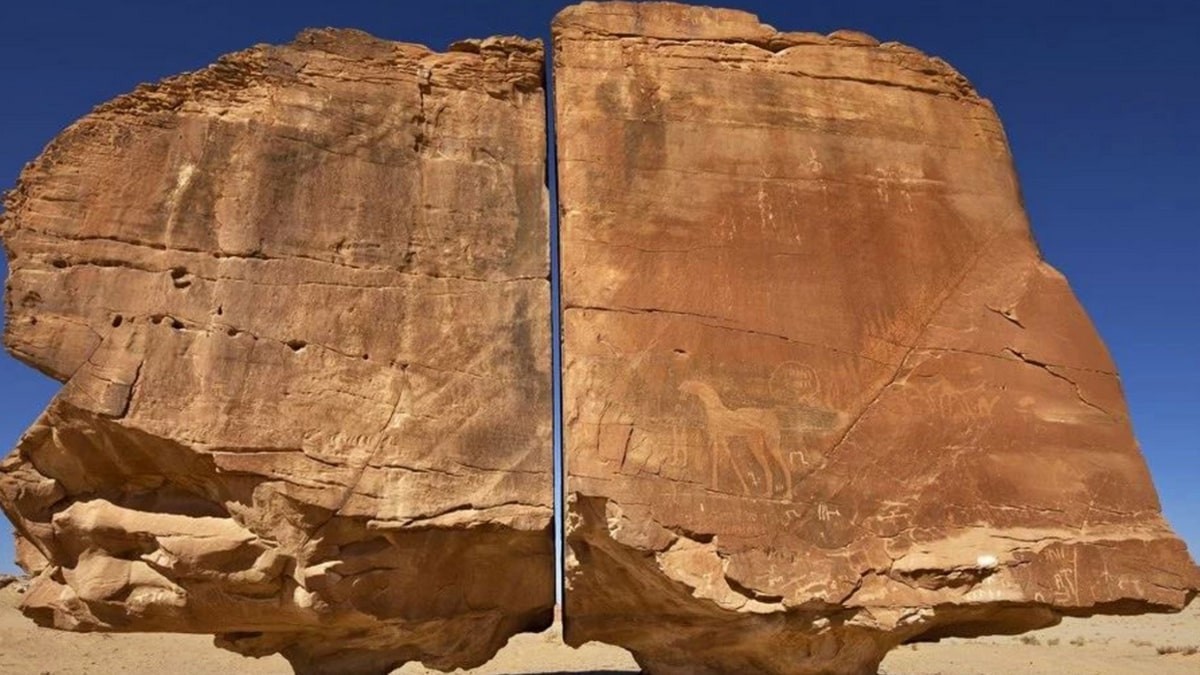 |
| Photo: Al Arabiya |
Across the years, historians have tried to understand the features that set Al Naslaa apart from the thousands of similar sandstone formations in the Saudi Arabian oasis. In addition to its split, one thing that is unique about Al Naslaa is the smoothness of the front of the rock, despite the round/jagged shaping on either side.
If you were to look at the rock from the side rather than the front, the smoothed-out surface concealing the famous crack might make it look as if though someone sanded the front-facing portion of the formation down. And technically, the elements have.
The likely cause of the split
According to geologists, the likely cause for the split is tectonic motion. The most likely natural cause of the formation is that the ground shifted ever-so-slightly beneath the supporting beam of one half of the rock, and it caused the rock to split into two. This is the most widely supported theory in the scientific world, though others have speculated at other natural (and unnatural) causes for the rock’s separation.
Other scientists theorize that the split is, in fact, a fault line, as the material surrounding faults tends to be weaker and erode more easily at the will of the elements. If this is the case, then the wind is likely what tore away at the weak material of the fault, leaving behind the near-solid remaining halves of the rock.
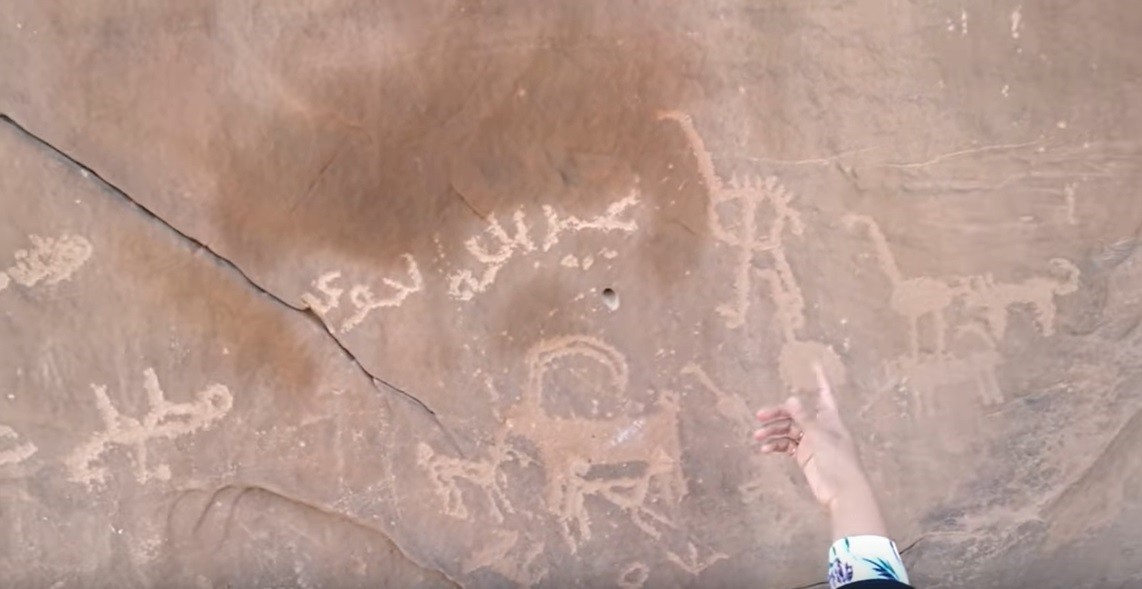 |
| The drawings on the rock. Anand Kumar Rudra / YouTube |
In addition, there is potential that the split is the result of a joint (fractures formed at weak points in rock formations) that may have been formed by a type of erosion, such as wind, water or ice.
However, there are still more theorists who believe that the formation is not a natural occurrence at all. Although scientific evidence backs up the idea that Al Naslaa was not man-made, the conflicting opinions of its formation—in addition to its perfect split—have caused some to turn to other sources of explanation…including the supernatural.
In addition to the potential natural causes of Al Naslaa, many people—from scientists to conspiracy theorists—have other ideas about how the rock gained its unusual shape. One such theory? Aliens. Considering the formation looks as if though it was cut apart by a well-aimed laser, some believe that a U.F.O. descended into the Tayma Oasis and zapped the rock apart with advanced technology not available to humans at its formation.
While this is a more bizarre theory, plenty of people have put their chips into it, believing that the break between the two halves of the rock is too perfect to have been produced by erosion. In addition, there are others who feel that there is a potential that the ancient settlers of the civilization that first came into contact with Al Naslaa were the ones who managed to split the rock apart. Still, their theories about how they pulled this off might be even tougher to believe than the theory about aliens.
The mysterious kingdom of Saudi Arabia
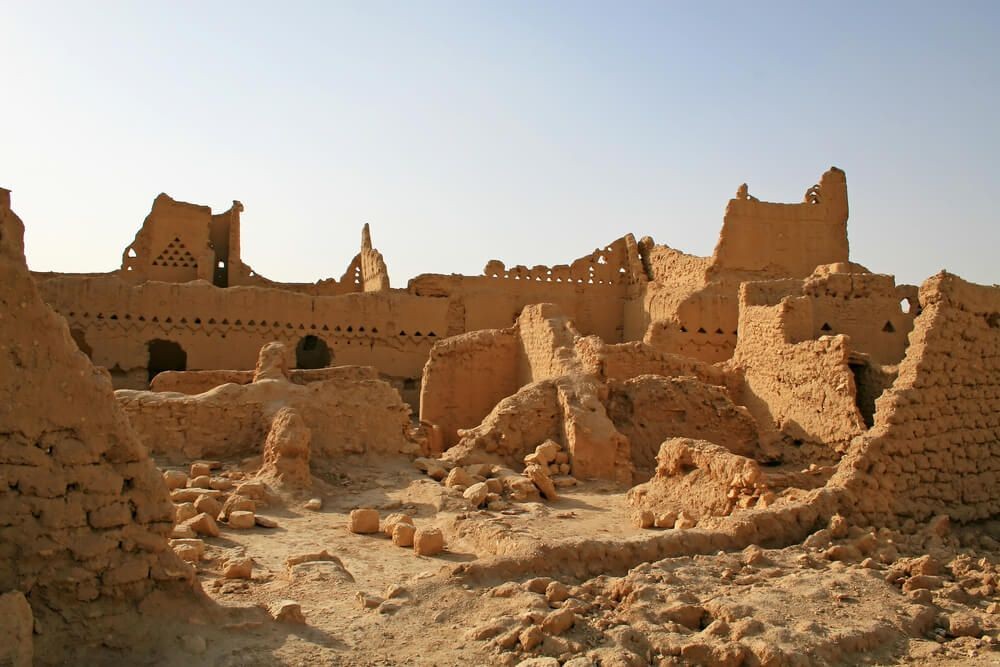 |
| Photo: Hundred Rooms |
Unfortunately Saudi Arabia is actually one of the most difficult countries to visit in the world. If you are not a practising Muslim or working in the country it’s hard to get in. But if you manage to do it you’ll definitely be rewarded. You can also visit the Madain Saleh which has over 131 ancient tombs, or the clay ruins in Diriyah, which were declared World Heritage site by UNESCO.
There are restrictions to be able to visit this place as its only open if you decide to travel for scientific or cultural reasons, or if a host here decides to invite you for a visit, otherwise for religious or business. Despite being full of natural wonders, we can’t forget that this country is one of the most conservative in the Middle East, governed by Islamic law and the Koran. People hope that one day it will be much easier to visit some of these great natural wonders of the world.
Why do you think this rock has this perfect split through the middle? Due to its position, Al Naslaa Rock is one of the most fascinating in the world, although scientists are still unsure of how it got this way.
 | Explore Top 7 Wonderful and Must-Visit Wildlife Hot-Spots in Southeast Asia From Komodo National Park in Indonesia to Ba Be National Park, these wonderful places have some of the world's most facisnating wildlife that will amaze ... |
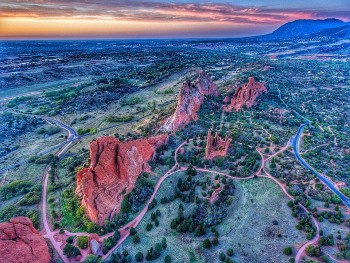 | Step Into The Wilderness: Visit The Mesmerizing “Garden of The Gods” Garden of the Gods, a mesmerizing public park with 300-million-year old sandstone rock formations, is a famous destination in the United States. |
 | Visit Mrauk U - The Dreamy Forgotten Heaven of Myanmar As a forgotten heaven, Mrauk U is a hidden ancient city that is nestled in a quite place in Myanmar, where its beauty and mysteries ... |
Recommended
 Travel
Travel
Vietnam Through Australian Eyes: Land of Flavor, Warmth, and Timeless Charm
 Travel
Travel
Strategies for Sustainable Growth of Vietnam’s Tourism from International Markets
 Travel
Travel
Vietnam Strengthens Its Presence On The Global Tourism Map
 Multimedia
Multimedia
Phong Nha-Ke Bang National Park Named Top Adventure Travel Site
 Travel
Travel
Vietnam Welcomes Record-High Number of International Visitors
 Travel
Travel
Luxury Train From Hanoi To Hai Phong To Be Launched In May
 Travel
Travel
Phong Nha Named Top Budget-Friendly Travel Destination for Spring 2025: Agoda
 Travel
Travel


